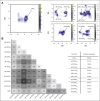Type 2M/2A von Willebrand disease: a shared phenotype between type 2M and 2A
- PMID: 38315875
- PMCID: PMC10997909
- DOI: 10.1182/bloodadvances.2024012626
Type 2M/2A von Willebrand disease: a shared phenotype between type 2M and 2A
Abstract
Four variants have been continuously subjected to debate and received different von Willebrand disease (VWD) classifications: p.R1315L, p.R1315C, p.R1374H, and p.R1374C. We chose to comprehensively investigate these variants with full set of VWD tests, protein-modeling predictions and applying structural biology. Patients with p.R1315L, p.R1315C, p.R1374H, and p.R1374C were included. A group with type 2A and 2M was included to better understand similarities and differences. Patients were investigated for phenotypic assays and underlying disease mechanisms. We applied deep protein modeling predictions and structural biology to elucidate the causative effects of variants. Forty-three patients with these variants and 70 with 2A (n = 35) or 2M (n = 35) were studied. Patients with p.R1315L, p.R1374H, or p.R1374C showed a common phenotype between 2M and 2A using von Willebrand factor (VWF):GPIbR/VWF:Ag and VWF:CB/VWF:Ag ratios and VWF multimeric profile, whereas p.R1315C represented a type 2M phenotype. There was an overall reduced VWF synthesis or secretion in 2M and cases with p.R1315L, p.R1374H, and p.R1374C, but not in 2A. Reduced VWF survival was observed in most 2A (77%), 2M (80%), and all 40 cases with p.R1315L, p.R1374H, and p.R1374C. These were the only variants that fall at the interface between the A1-A2 domains. p.R1315L/C mutants induce more compactness and internal mobility, whereas p.R1374H/C display a more extended overall geometry. We propose a new classification of type 2M/2A for p.R1315L, p.R1374H, and p.R1374C because they share a common phenotype with 2M and 2A. Our structural analysis shows the unique location of these variants on the A1-A2 domains and their distinctive effect on VWF.
© 2024 by The American Society of Hematology. Licensed under Creative Commons Attribution-NonCommercial-NoDerivatives 4.0 International (CC BY-NC-ND 4.0), permitting only noncommercial, nonderivative use with attribution. All other rights reserved.
Conflict of interest statement
Conflict-of-interest disclosure: F.P. serves on the advisory committees of CSL Behring, Biomarin, Roche, Sanofi, and Sobi, and participated in educational meetings/symposia of Takeda/Spark. The remaining authors declare no competing financial interests.
Figures







References
-
- Rodeghiero F, Castaman G, Dini E. Epidemiological investigation of the prevalence of von Willebrand’s disease. Blood. 1987;69(2):454–459. - PubMed
-
- Werner EJ, Broxson EH, Tucker EL, Giroux DS, Shults J, Abshire TC. Prevalence of von Willebrand disease in children: a multiethnic study. J Pediatr. 1993;123(6):893–898. - PubMed
-
- Bowman M, Hopman W, Rapson D, Lillicrap D, James P. The prevalence of symptomatic von Willebrand disease in primary care practice. J Thromb Haemostasis. 2010;8(1):213–216. - PubMed
-
- Bloom AL. Elsevier; 1991. von Willebrand factor: clinical features of inherited and acquired disorders. Mayo Clinic Proceedings; 1991; pp. 743–751. - PubMed

